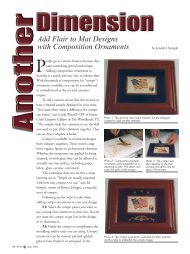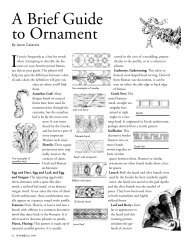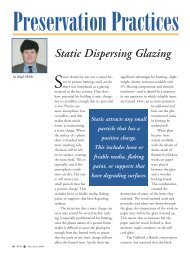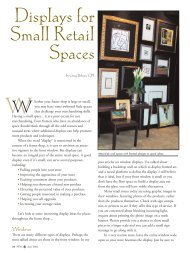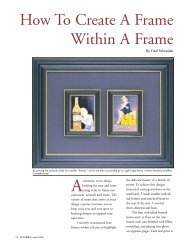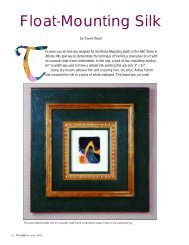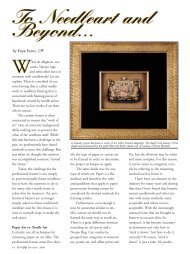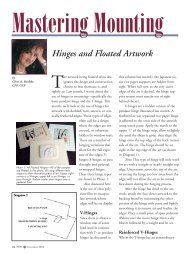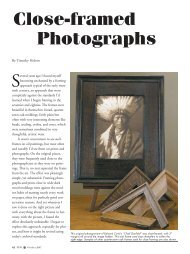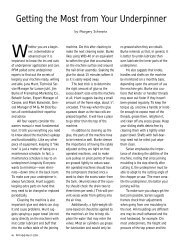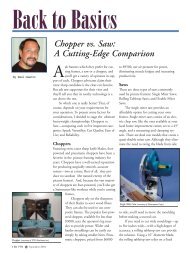TABLE OF CONTENTS - Picture Framing Magazine
TABLE OF CONTENTS - Picture Framing Magazine
TABLE OF CONTENTS - Picture Framing Magazine
Create successful ePaper yourself
Turn your PDF publications into a flip-book with our unique Google optimized e-Paper software.
Figure 8<br />
staples must be aligned on opposite<br />
sides of the joint to perform properly.<br />
Cross and corner braces can further<br />
enhance the performance of the strainer.<br />
Corner braces need not be very long to<br />
add to the rigidity of the corners and can<br />
be cut from the scrap left from cutting<br />
the strainer itself. Cross braces are<br />
needed when the size of the frame grows<br />
and even the stiffening effect of the<br />
width of the strainer may be challenged<br />
by the length of the sides of the frame.<br />
These should be glued and stapled in the<br />
same manner as the rest of the strainer.<br />
The strainer must be screwed to the<br />
frame to complete its installation.<br />
Nailing the two together will deliver<br />
blows to the frame which will be unacceptable<br />
for the art inside.<br />
The two commonly used techniques<br />
for screwing the strainer to the frame<br />
involve countersinking the scre w s<br />
through the side of the frame into the<br />
side of the strainer [FIGURE 8], or<br />
countersinking the screws in the back of<br />
the strainer so that they angle forward<br />
and out into the inside of the frame [FIG-<br />
URE 9]. Setting the screws in the side of<br />
the frame raises aesthetic and physical<br />
problems. If the frame is made of wood<br />
which has been given a clear finish,<br />
brass screws are usually employed.<br />
Silver metal frames are usually attached<br />
with stainless steel or other silver colored<br />
screws, while painted frames are<br />
usually secured with screws which have<br />
been painted to match the frame.<br />
S c rews placed in the sides of the<br />
frame can only enter the strainer if it is<br />
set in a part of the frame which is adjacent<br />
to them. If the frame is re f u r b i s h e d<br />
to provide more spacing between the<br />
glazing and the art, the strainer may be<br />
too far back to accept the scre w s .<br />
Putting the screws in from the sides<br />
leads to a further problem if the frame is<br />
l a rge, since such frames should not be<br />
laid on their backs or turned on their<br />
sides, and putting in or taking out the<br />
s c rews on the bottom of the frame will<br />
involve placing it on blocks off the floor<br />
and working under it as an auto<br />
mechanic might.<br />
If the screws are angled toward the<br />
frame from the back of the strainer, any<br />
color screws can be used since they will<br />
not be seen. The creation of the holes in<br />
the back of the strainer can pose some<br />
difficulties. It is easiest to hold a drill<br />
with a good countersinking bit in it so<br />
that the drill is initially perpendicular to<br />
the surface of the strainer and the point<br />
of the bit is at a spot which will become<br />
the opening of the hole. Once the hole<br />
has been started, the drill can be angled<br />
and the boring can proceed to a point at<br />
which the head of the screw will be<br />
beneath the surface of the wood. The bit<br />
shouldcome through the side of the<br />
Figure 9<br />
strainer but care must be exercised to<br />
avoid overdrilling.<br />
The strainer should have the same<br />
outside dimensions as the mat package.<br />
This means that the strainer will be<br />
smaller than the frame by the customary<br />
allowance. This will result in some loss<br />
of support in the corners, but it will allow<br />
the strainer to pull the sides of the frame<br />
in to fit the glazing/matting/backing<br />
board package. This clearance is especially<br />
important when using metal<br />
frames, since the wood may expand as it<br />
ages and the frame can not.<br />
If a strainer is found to be too tight<br />
when it is removed from an old frame, it<br />
can be planed or cut down at the corners<br />
only and refitted. The centers of the<br />
sides of the frame will flex out to accommodate<br />
the size to the strainer, and<br />
unless the spacer or glazing is in peril of<br />
becoming dislodged, this extra space<br />
will permit greater expansion of the matting<br />
materials inside of the frame.



